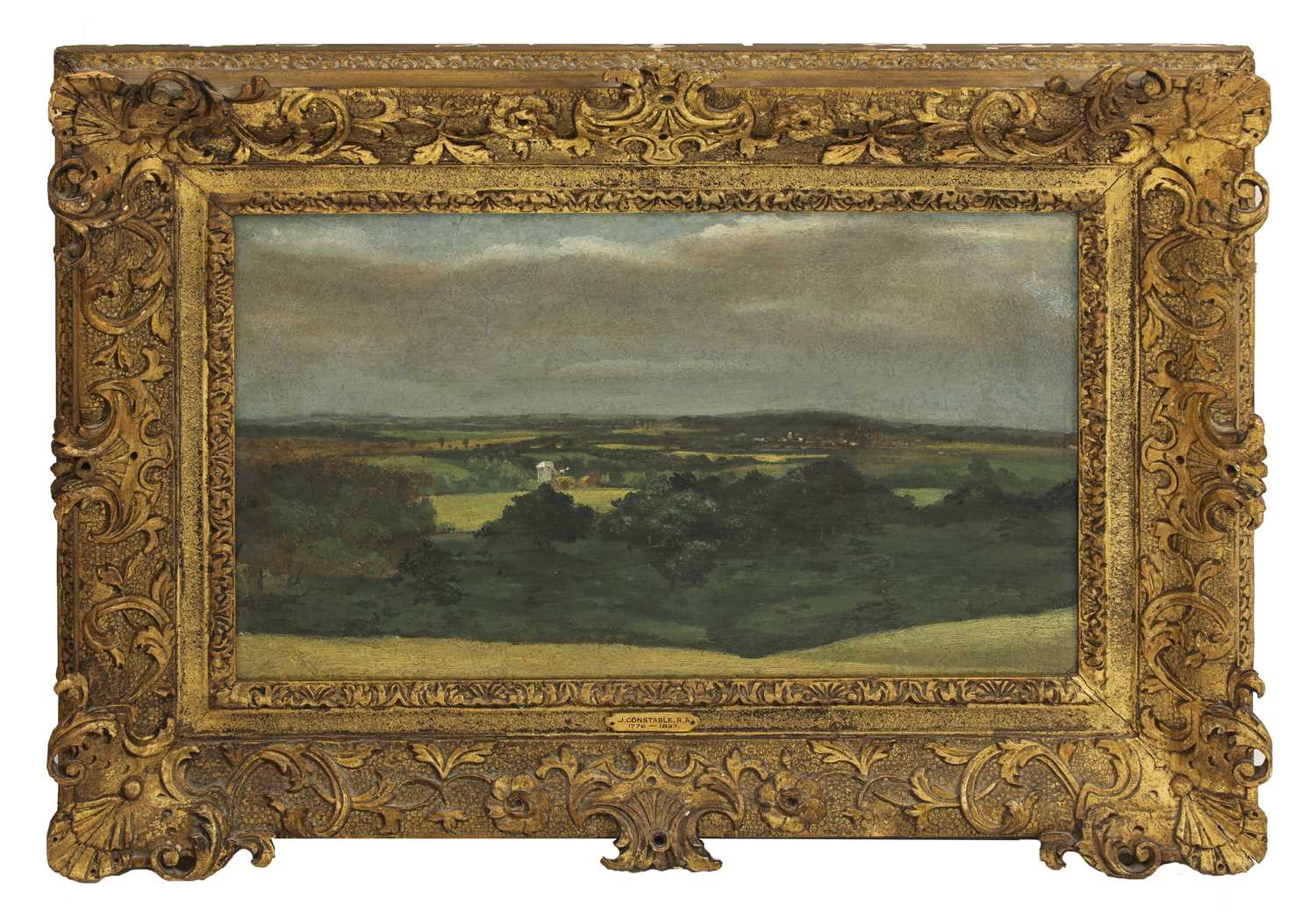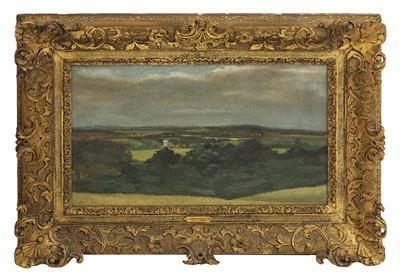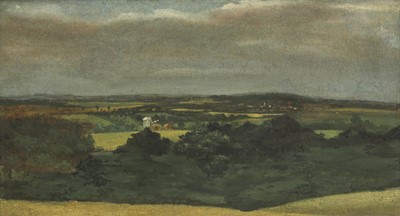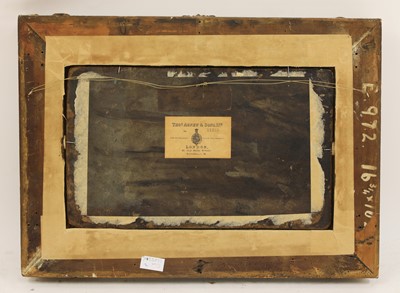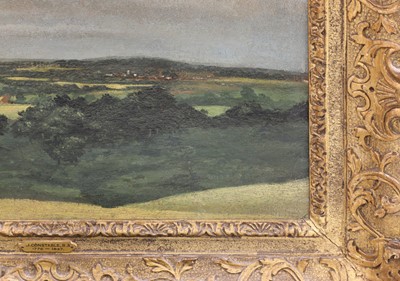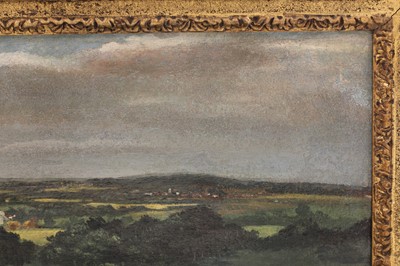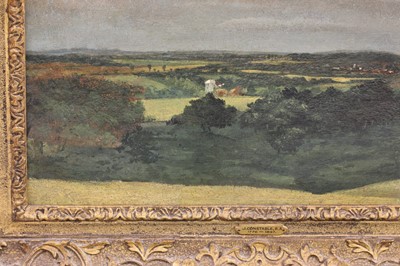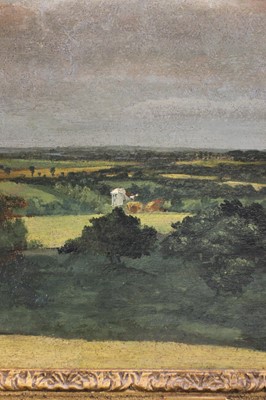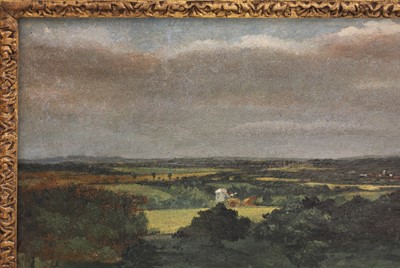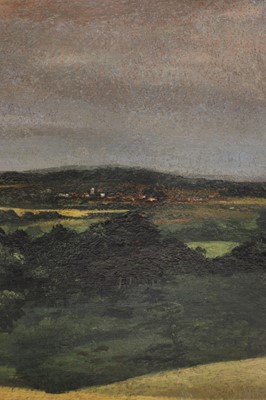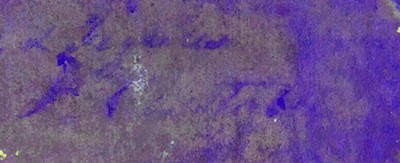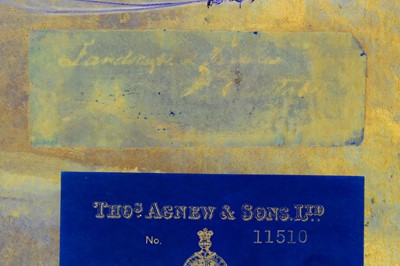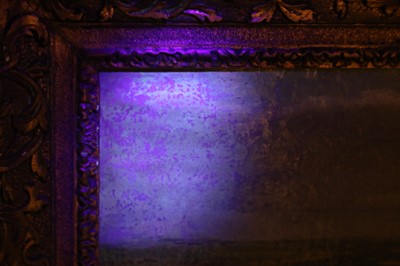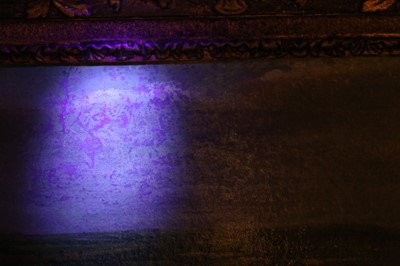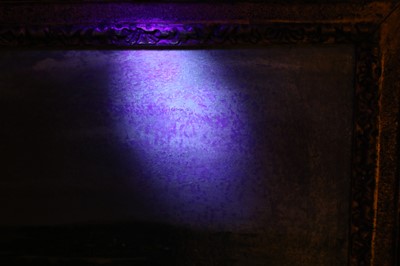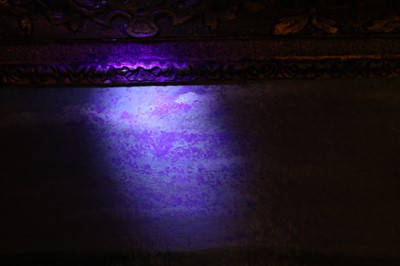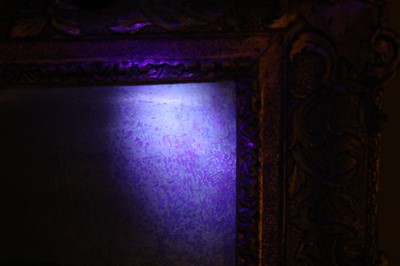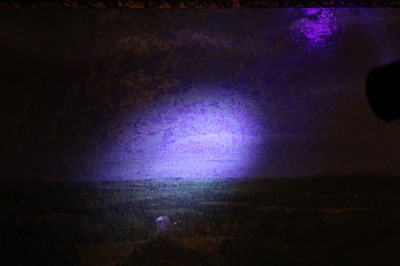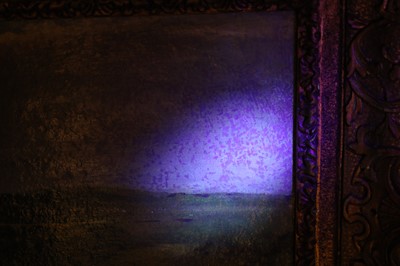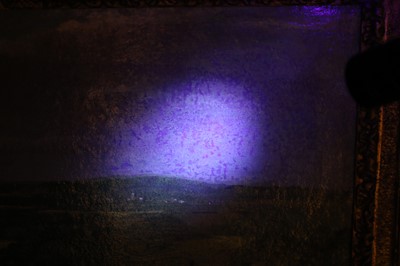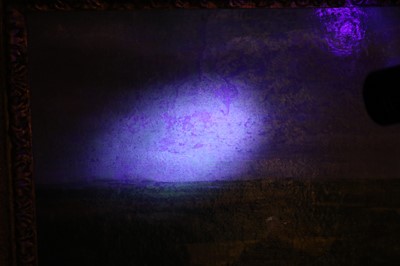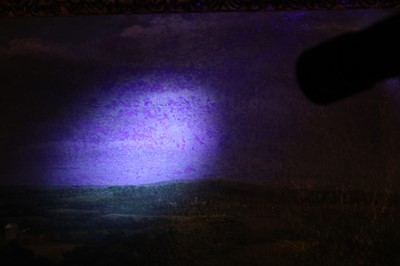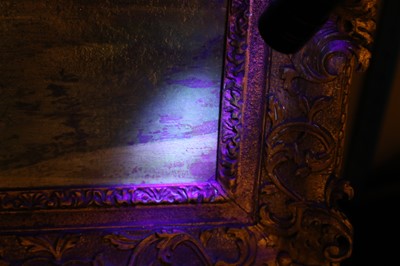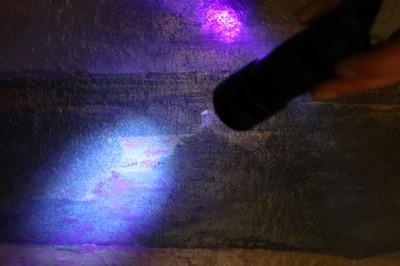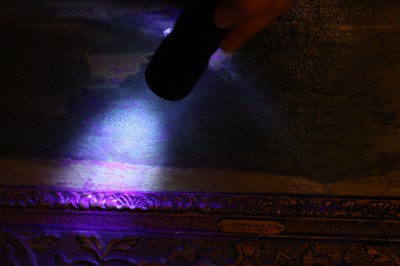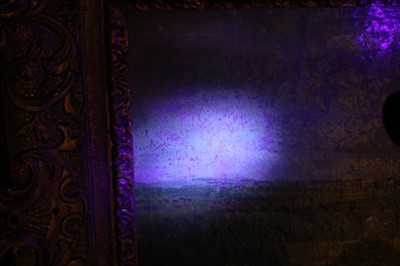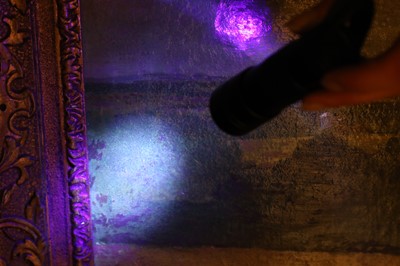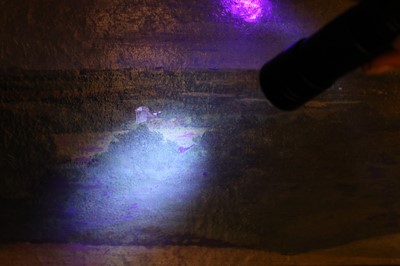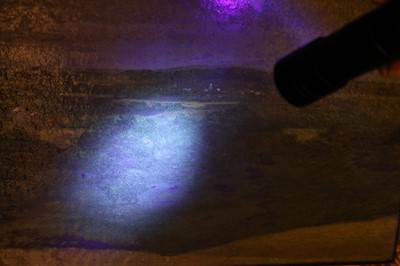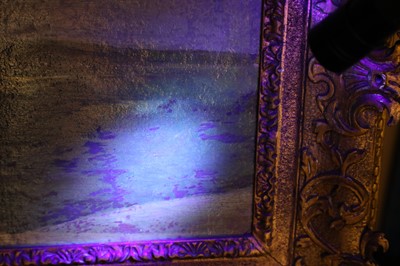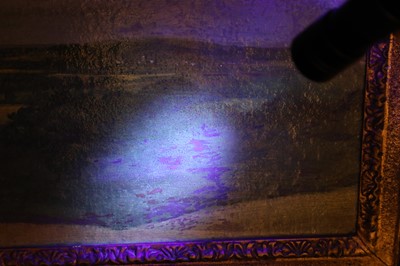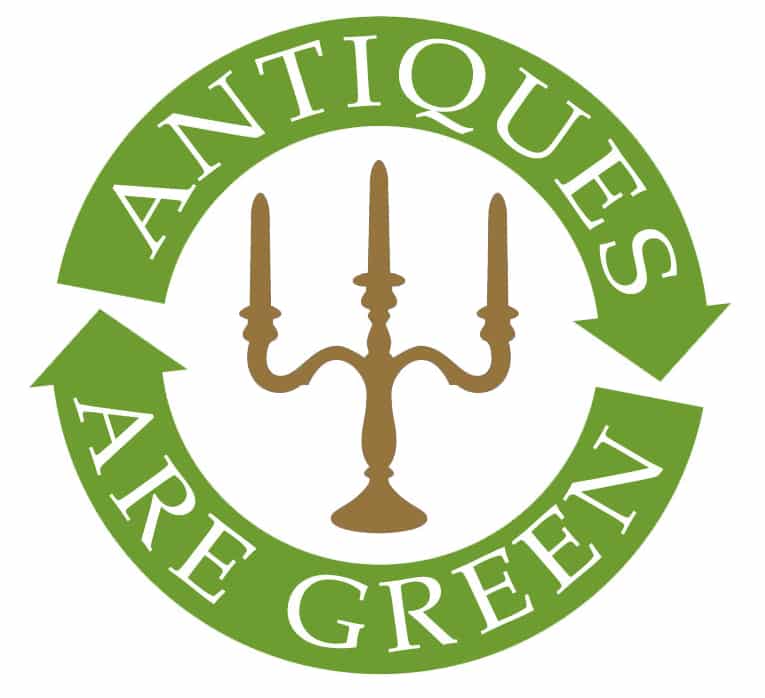9th Dec, 2020 10:00
Fine Interiors - Two Day Sale - Live Online
695
John Constable RA (1776-1837)
John Constable RA (1776-1837)
Dedham Vale with Brantham mill and haystacks, c.1809-10
oil on millboard
26.8 x 43.3cm, in a gilt carved wood frame
The present view is looking south over Dedham Vale with the Church and sprawling village, and the far snaking line of the Stour against the southern higher ground.
Provenance: Probably a member of the Constable family;
Leggatt Brothers, London;
Agnews (11510), sold 1946 to Major A.W. Allen (stock number 9159);
and by descent to the vendor
Verso: old label indistinctly inscribed ‘Landscape & ...’
This previously unrecorded early oil sketch by John Constable is an exciting new discovery, and forms a useful new addition to the Constable literature. The fact that the picture once passed through the hands of Leggatt Brothers points towards a likely provenance direct from a member of the Constable family.
During the first half of his career, when visiting the family home at East Bergholt during the summer and often sketching from nature there, Constable would tend to focus on two key landscape subjects: panoramic views overlooking the Stour valley, most especially vistas of Dedham Vale; or more enclosed views made in and around the mill at Flatford belonging to his father, Golding Constable.
Constable’s paintings of Dedham Vale are usually taken from two favourite viewpoints: either (as is the case with this sketch) from the Suffolk side of the valley looking westwards across the Vale; or, as painted by him from as early as 1802, from the Essex side of the valley, from higher ground on Gun Hill, looking eastwards.
The most famous representation by Constable of the former composition is the panorama of Dedham Vale, seen from the East Bergholt to Flatford Lane, which he sent to the Royal Academy in 1811 with the title 'Dedham Vale, Morning' (Proby Collection, Elton Hall; see Graham Reynolds, 'The Early Paintings and Drawings of John Constable', 1996, Yale University Press, no. 11.02). Constable made a number of preparatory oil sketches for this composition, which - like the final picture itself - show the towers of various Suffolk or Essex churches in the distance, of Stratford St Mary, Langham and Dedham (see Reynolds op.cit, R.11. 04-06). In these related sketches, Constable indicates the distant church towers with simple little white flecks of paint. This is his personal shorthand for showing their position in the landscape as well, no doubt, as to show the way they catch the light depending on the time of day and position of the sun.
This previously unrecorded oil sketch shows the unmistakable tall tower of Dedham Church (and its adjacent village) in the far right hand distance. As Constable’s viewpoint here is clearly further east than the one he adopted for 'Dedham Vale: Morning', 1811, the two church towers of Stratford St Mary and Langham are no longer visible in the distance (they are out of sight on the right). Instead a windmill - apparently a weatherboarded post mill - has now come into view in the left hand middle distance. Like the towers of the local churches, Constable has rendered this mill in prominent strokes of white paint.
By examining an ordnance survey map dating from the early nineteenth century, one can deduce that the windmill Constable shows here is likely to be identifiable as one situated at Brantham (see Ordnance Survey Map Sheet 64, Colchester; facsimile version of 1838 re-engraved map, on four quarter plates, based on 1805 single sheet impression of map). In fact Brantham boasted two mills in Constable’s day, both situated - a little to the south-west of Brantham village - on the river Stour where there was also a Lock - indeed Brantham Lock was the last of the 15 locks which, since the time of their construction in the eighteenth century, had rendered the River Stour navigable from Sudbury to Manningtree.
Of the two windmills at Brantham, one was a wind driven postmill with sails - tentatively identified as the one Constable has painted here - and the other a tidal mill driven by water. As Ian Fleming-Williams pointed out, this was a convenient arrangement, as it meant that one could be used when the other was unable to work ('Constable and his Drawings', 1990, p.111). Both mills at Brantham are shown, sited very close to each other, in a tiny pencil sketch Constable made in 1814 ( Reynolds, op.cit, 14.23, albeit only the roof of the tidal mill is visible in this sketch). The mill shown in Constable’s oil sketch meanwhile is, as indicated above, likely to be identifiable from its sails as the wind driven post mill at Brantham (the tidal mill presumably being out of sight). Constable had made a more detailed drawing of this mill, in pencil and stump, as early as 1802 in which he showed its exact position on the river, and where the structure of the mill building can be made out in more detail ('The Windmill at Brantham', Victoria & Albert Museum, see Reynolds, op. cit, 02.8). He made a further sketch of the windmill at Brantham in the intact 1814 sketchbook in the Victoria & Albert Museum ( Reynolds, op.cit, 14.32, p.47).
Windmills frequently caught Constable’s attention as potential subject matter for his art given his father’s profession as a corn (and coal) merchant. Not only did Golding Constable own mills at Flatford and Dedham, but he seems also to have owned the windmill at Brantham, and certainly had a coal-yard at the latter location (Fleming-Williams, op.cit, p. 112). The area around Brantham, then, would have been familiar territory for Constable during the first half of his career, and perhaps especially in the period 1805-8 when the young artist was involved in painting an altarpiece for the church at Brantham ('Christ Blessing the Children', 1805-8, on loan to Emmanuel College, Cambridge, Reynolds 05.2).
Constable’s oil sketch of 'Dedham Vale with Brantham Mill' is painted on millboard, a support Constable is known to have taken up for oil sketching in the period around 1809, perhaps influenced by the adoption of the same support for sketching by his patron and mentor, Sir George Beaumont. Constable’s use of millboard here, together with the stylistic handling – strong tonal contrasts and a fairly even application of paint - point towards a date of c.1809-10. A view of 'Malvern Hall from the South-West' of 1809 in the Bristol Museums and Art Gallery (see right in catalogue), although executed on paper laid on canvas, is very similar in handling.
I am especially grateful to John Somerville who kindly pointed out to me that the viewpoint is probably the furthest East that Constable ever painted Dedham Vale, and therefore that the mill is most likely to be that at Brantham owned by his father, Golding Constable.
Anne Lyles
We are grateful to Anne Lyles for her assistance in the cataloguing of this lot.
Take advantage of our Sworders Delivery Service. Please see 'Shipping estimate' below.
Sold for £70,000
Condition Report
Oil on board. The board is fragile and brittle; the edges are very friable. Old tears in the support are visible at the top and bottom edges. There is a sketch on the reverse of the board with remnants of old paper tape around the edges. The oil painting on the front of the board is in a stable condition. There are losses associated with the tears and localised damages. There are scattered retouchings across the surface of the painting which are matte and are slightly mismatched to the original. The retouchings cover areas of damage and spots of wear and abrasion. In the sky the retouching gives the painting a slightly mottled appearance. The varnish is clear and glossy. The frame is in a good condition with a few scattered losses to the gilding on the sides. The painting is poorly secured in the frame with bent nails and cork spacers.
IN PERSON
To bid in person at auction for the first time please register for a bidding paddle in advance by filling out and submitting a registration form at our front desk. When registering in person we require photo ID, such as a passport or driving licence.
ABSENTEE BIDDING
If you cannot attend the auction in person we can bid on your behalf. You can leave an absentee bid on our website.
The amount you bid should be your maximum bid. We will bid up to that limit for you, and remember you may end up paying less than your limit, depending on other bidding on the day.
You can leave an absentee bid up to half an hour before the start of any sale. Please note when we receive two or more absentee bids for the same amount, the first bid received will be the one taken.
LEAVE COMMISSION BIDS ONLINE
If you would like to leave a commission bid on our website you can do so up until 30 minutes before the sale starts. Leaving a commission bid through sworder.co.uk is free for all registered clients. Thereafter you may register bank card details under your account in order to bid live. Click here to register an account.
BID LIVE ON sworder.co.uk
You can bid live at our auctions from the comfort of your home or office using bidding platform Sworders Live. It is easy to register and you can watch the auction live as it happens. A 'Bid Live' button will appear on the auction on our website homepage when a sale is live; simply click the button to sign in or register with your card details. There is no additional charge for this service.
For further instructions on registering to bid live, please click here.
TELEPHONE BIDDING
If you would like to bid by telephone please contact our team prior to the auction with your details of the lots you are interested in and your full name, address, telephone number(s) and email address. Once our team have entered your bid request you will receive an email confirmation. We will contact you during the sale and one of our team will bid live with you over the phone.
Please note that we normally offer this service for lots with an estimate of £500 or higher and all telephone bid requests must be received by close of business the day before the auction.
Auction: Fine Interiors - Two Day Sale - Live Online, 9th Dec, 2020
Viewing
VIEWING BY APPOINTMENT
Due to current social distancing restrictions, we will be offering viewing by appointment only. One hour time slots will be available from:
Fri 4 December, 9am - 5pm;
Sat 5 December, 10am - 4pm;
Sun 6 December, 10am - 4pm;
Mon 7 December, 9am - 5pm
REMOVAL OF LOTS
Please note that all lots should be removed by 5pm on Monday 4 January 2021. Furniture lots remaining after this date will be removed to Perry Removals, Chapel End, Broxted, Essex CM6 2BW. Removal will be at a cost of £20 +VAT per lot and storage will be charged at £2 +VAT per lot, per day.
Sorry, we cannot calculate a pre-sale automated shipping cost due to the items weight/size.
Should you be successful in buying this item, a specific shipping estimate can be requested after the sale by using the link in your invoice email; this also includes requests for international delivery.
If you would like further information about shipping and collection please see here.
Buying a pre-loved, antique, or vintage item not only provides you with unique style and value for money but it also helps to reduce landfill, and the annual emissions of an antique or vintage piece can be as little as one sixteenth of those of its new equivalent!
Sworders is proud to be supporting the work of Antiques are Green - the movement that was founded in 2009 to promote “a greener future created from the past”. Read their fascinating carbon footprint study of a Georgian chest of drawers versus a modern equivalent here
Request A Valuation
Here at Sworders, we are happy to offer a free online valuation service. Please fill out the form and press the 'Submit' button below.
To help us with your valuation please attach clear photographs of the item where possible. You can submit up to 5.
Approximate dimensions are also useful. Expect to hear from the appropriate valuer as soon as possible.
